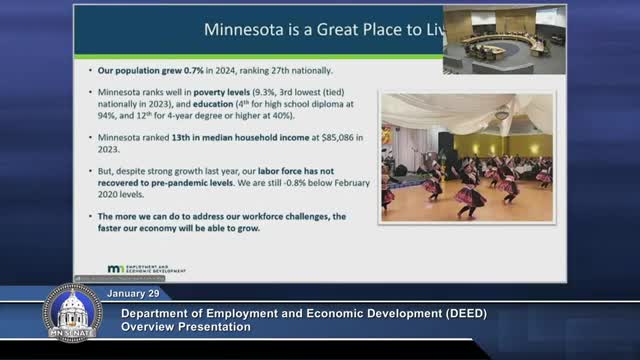Minnesota reports 6 straight months of job growth amid improving economic outlook
January 29, 2025 | 2025 Legislature MN, Minnesota
This article was created by AI summarizing key points discussed. AI makes mistakes, so for full details and context, please refer to the video of the full meeting. Please report any errors so we can fix them. Report an error »

During a recent meeting of the Minnesota Senate Committee on Jobs and Economic Development, key discussions highlighted the state's economic performance and demographic trends. The meeting, held on January 29, 2025, provided insights into Minnesota's population growth, labor market conditions, and ongoing challenges related to income and employment disparities.
The state's population grew by 0.7% in 2024, placing Minnesota 27th nationally. This modest growth is seen as a positive sign, especially when considering the net loss from domestic migration was significantly smaller compared to the unusual figures from 2022. The committee expressed optimism that initiatives like Explore Minnesota for Business, which received funding from the governor, could further enhance these trends.
In terms of economic health, Minnesota ranks third lowest in poverty levels at 9.3%, indicating a relatively strong position. However, the committee acknowledged the need for continued efforts to reduce poverty further. Educational attainment and median household income also ranked favorably, with Minnesota holding the 13th position nationally.
The labor market showed promising signs, with six consecutive months of net job growth and a total of 3 million jobs—the highest number recorded in the state. The unemployment rate stands at a low 3.3%, significantly below the national average. Despite these positive indicators, the committee noted persistent disparities in income and employment, emphasizing that addressing unemployment is just the first step. Further efforts are needed to tackle wage and wealth inequalities.
Overall, the discussions underscored a resilient Minnesota economy, while also highlighting the ongoing challenges that require attention from state agencies and partners. The committee's focus on these issues reflects a commitment to fostering a more equitable economic landscape for all Minnesotans.
The state's population grew by 0.7% in 2024, placing Minnesota 27th nationally. This modest growth is seen as a positive sign, especially when considering the net loss from domestic migration was significantly smaller compared to the unusual figures from 2022. The committee expressed optimism that initiatives like Explore Minnesota for Business, which received funding from the governor, could further enhance these trends.
In terms of economic health, Minnesota ranks third lowest in poverty levels at 9.3%, indicating a relatively strong position. However, the committee acknowledged the need for continued efforts to reduce poverty further. Educational attainment and median household income also ranked favorably, with Minnesota holding the 13th position nationally.
The labor market showed promising signs, with six consecutive months of net job growth and a total of 3 million jobs—the highest number recorded in the state. The unemployment rate stands at a low 3.3%, significantly below the national average. Despite these positive indicators, the committee noted persistent disparities in income and employment, emphasizing that addressing unemployment is just the first step. Further efforts are needed to tackle wage and wealth inequalities.
Overall, the discussions underscored a resilient Minnesota economy, while also highlighting the ongoing challenges that require attention from state agencies and partners. The committee's focus on these issues reflects a commitment to fostering a more equitable economic landscape for all Minnesotans.
View full meeting
This article is based on a recent meeting—watch the full video and explore the complete transcript for deeper insights into the discussion.
View full meeting
